Experimental and Numerical Investigations on the Flow Characteristics within Hydrodynamic Entrance Regions in Microchannels
Abstract
1. Introduction
2. Experimental Description
2.1. Microchannel Fabrication
2.2. Experimental Setup
2.3. Experimental Uncertainty
3. Experimental Results and Discussion
3.1. Developing Velocity Profiles
3.2. Velocity Development Along Centerline
3.3. Correlations of Hydraulic Entrance Length
4. Numerical Simulation
4.1. Investigation Method
4.2. Results and Discussion
5. Conclusions
Author Contributions
Funding
Conflicts of Interest
References
- Tuckerman, D.; Pease, R. High-performance heat sinking for VLSI. IEEE Electron Device Lett. 1981, 2, 126–129. [Google Scholar] [CrossRef]
- Mishan, Y.; Mosyak, A.; Pogrebnyak, E.; Hetsroni, G. Effect of developing flow and thermal regime on momentum and heat transfer in micro-scale heat sink. Int. J. Heat Mass Transf. 2007, 50, 3100–3114. [Google Scholar] [CrossRef]
- Muwanga, R.; Hassan, I.; Macdonald, R. Characteristics of Flow Boiling Oscillations in Silicon Microchannel Heat Sinks. J. Heat Transf. 2007, 129, 1341–1351. [Google Scholar] [CrossRef]
- Mario Di Capua, H.; Escobar, R.; Díaz, A.; Guzmán, A. Enhancement of the cooling capability of a high concentration photovoltaic system using microchannels with forward triangular ribs on sidewalls. Appl. Energy 2018, 226, 160–180. [Google Scholar] [CrossRef]
- Liu, Z.; Qin, S.; Chen, X.; Chen, D.; Wang, F. PDMS-PDMS Micro Channels Filled with Phase-Change Material for Chip Cooling. Micromachines 2018, 9, 165. [Google Scholar] [CrossRef]
- Ling, W.; Zhou, W.; Yu, W.; Zhou, F.; Chen, J.; Hui, K.S. Experimental investigation on thermal and hydraulic performance of microchannels with interlaced configuration. Energy Convers. Manag. 2019, 174, 439–452. [Google Scholar] [CrossRef]
- Nguyen, N.-T.; Wu, Z. Micromixers—A Review. J. Micromech. Microeng. 2005, 15, R1–R16. [Google Scholar] [CrossRef]
- Demello, A.J. Control and detection of chemical reactions in microfluidic systems. Nature 2006, 442, 394–402. [Google Scholar] [CrossRef] [PubMed]
- Chang, C.-C.; Yang, R.-J. Electrokinetic mixing in microfluidic systems. Microfluid. Nanofluid. 2007, 3, 501–525. [Google Scholar] [CrossRef]
- Chen, X.; Li, T.; Zeng, H.; Hu, Z.; Fu, B. Numerical and experimental investigation on micromixers with serpentine microchannels. Int. J. Heat Mass Transf. 2016, 98, 131–140. [Google Scholar] [CrossRef]
- Clark, J.; Kaufman, M.; Fodor, P.S. Mixing Enhancement in Serpentine Micromixers with a Non-Rectangular Cross-Section. Micromachines 2018, 9, 107. [Google Scholar] [CrossRef] [PubMed]
- Vatankhah, P.; Shamloo, A. Parametric study on mixing process in an in-plane spiral micromixer utilizing chaotic advection. Anal. Chim. Acta 2018, 1022, 96–105. [Google Scholar] [CrossRef] [PubMed]
- Shah, R.K.; London, A.L. Laminar Flow Forced Convection in Ducts; Advances in Heat Transfer—Supplement 1; Academic Press: New York, NY, USA, 1978. [Google Scholar]
- Yun, H.; Chen, B.; Chen, B. Numerical Simulation of Geometrical Effects on the Liquid Flow and Heat Transfer in Smooth Rectangular Microchannels. In Proceedings of the ASME 2009 Second International Conference on Micro/Nanoscale Heat and Mass Transfer, Shanghai, China, 18–21 December 2009; Volume 3, pp. 271–277. [Google Scholar]
- Rohsenow, W.M.; Hartnett, J.P. Handbook of Heat Transfer; McGraw-Hill: New York, NY, USA, 1973. [Google Scholar]
- Beavers, G.; Sparrow, E.; Magnuson, R. Experiments on hydrodynamically developing flow in rectangular ducts of arbitrary aspect ratio. Int. J. Heat Mass Transf. 1970, 13, 689–701. [Google Scholar] [CrossRef]
- Sparrow, E.M.; Hixon, C.W.; Shavit, G. Experiments on Laminar Flow Development in Rectangular Ducts. J. Basic Eng. 1967, 89, 116–123. [Google Scholar] [CrossRef]
- Goldstein, R.J.; Kreid, D.K. Measurement of Laminar Flow Development in a Square Duct Using a Laser-Doppler Flowmeter. J. Appl. Mech. 1967, 34, 813–818. [Google Scholar] [CrossRef]
- Atkinson, B.; Brocklebank, M.P.; Card, C.C.H.; Smith, J.M. Low Reynolds Number Developing Flows. AIChE J. 1969, 15, 548–553. [Google Scholar] [CrossRef]
- Chen, R.-Y. Flow in the Entrance Region at Low Reynolds Numbers. J. Fluids Eng. 1973, 95, 153–158. [Google Scholar] [CrossRef]
- Wu, H.; Cheng, P. An experimental study of convective heat transfer in silicon microchannels with different surface conditions. Int. J. Heat Mass Transf. 2003, 46, 2547–2556. [Google Scholar] [CrossRef]
- Guo, Z.-Y.; Li, Z.-X. Size effect on microscale single-phase flow and heat transfer. Int. J. Heat Mass Transf. 2003, 46, 149–159. [Google Scholar] [CrossRef]
- Bocquet, L.; Barrat, J.-L. Flow boundary conditions from nano- to micro-scales. Soft Matter 2007, 3, 685–693. [Google Scholar] [CrossRef]
- Vasu, N.; De, S. Electroviscous effects in purely pressure driven flow and stationary plane analysis in electroosmotic flow of power-law fluids in a slit microchannel. Int. J. Eng. Sci. 2010, 48, 1641–1658. [Google Scholar] [CrossRef]
- Hsieh, S.-S.; Lin, C.-Y. Convective heat transfer in liquid microchannels with hydrophobic and hydrophilic surfaces. Int. J. Heat Mass Transf. 2009, 52, 260–270. [Google Scholar] [CrossRef]
- Mujumdar, A.S.; Wang, X.-Q.; Yap, C. Effects of Two-Dimensional Roughness in Flow in Microchannels. J. Electron. Packag. 2005, 127, 357–361. [Google Scholar]
- Zhang, X.; He, F.; Hao, P.; Gao, Y.; Sun, L.; Wang, X.; Jin, X. Characteristics of Liquid Flow in Microchannels at very Low Reynolds Numbers. Chem. Eng. Technol. 2016, 39, 1425–1430. [Google Scholar] [CrossRef]
- Lee, S.-Y.; Wereley, S.T.; Gui, L.; Qu, W.; Mudawar, I. Microchannel Flow Measurement Using Micro Particle Image Velocimetry. In Proceedings of the ASME International Mechanical Engineering Congress and Exposition (IMECE2002), ASME, New Orleans, LA, USA, 17–22 November 2002; Volume 258, pp. 493–500. [Google Scholar]
- Lee, S.-J.; Kim, G.-B. Analysis of Flow Resistance Inside Microchannels With Different Inlet Configurations Using Micro-PIV System. In Proceedings of the ASME 2003 1st International Conference on Microchannels and Minichannels, Rochester, NY, USA, 24–25 April 2003. ASME Paper No. ICMM2003-1108. [Google Scholar]
- Hao, P.-F.; He, F.; Zhu, K.-Q. Flow characteristics in a trapezoidal silicon microchannel. J. Micromech. Microeng. 2005, 15, 1362–1368. [Google Scholar] [CrossRef]
- Ahmad, T.; Hassan, I. Experimental Analysis of Microchannel Entrance Length Characteristics Using Microparticle Image Velocimetry. J. Fluids Eng. 2010, 132, 041102. [Google Scholar] [CrossRef]
- Santiago, J.G.; Wereley, S.T.; Meinhart, C.D.; Beebe, D.J.; Adrian, R.J. A particle image velocimetry system for microfluidics. Exp. Fluids 1998, 25, 316–319. [Google Scholar] [CrossRef]
- White, F.M. Viscous Fluid Flow, 3rd ed.; McGraw-Hill: New York, NY, USA, 2006. [Google Scholar]
- Celata, G.P.; Morini, G.L.; Marconi, V.; McPhail, S.J.; Zummo, G. Using Viscous Heating to Determine the Friction Factor in Microchannels: An Experimental Validation. Exp. Therm. Fluid Sci. 2006, 30, 725–731. [Google Scholar] [CrossRef]
- Morini, G.L. Viscous heating in liquid flows in micro-channels. Int. J. Heat Mass Transf. 2005, 48, 3637–3647. [Google Scholar] [CrossRef]
- Koo, J.; Kleinstreuer, C. Viscous dissipation effects in microtubes and microchannels. Int. J. Heat Mass Transf. 2004, 47, 3159–3169. [Google Scholar] [CrossRef]
- Galvis, E.; Yarusevych, S.; Culham, J.R. Incompressible Laminar Developing Flow in Microchannels. ASME J. Fluids Eng. 2012, 134, 014503. [Google Scholar] [CrossRef]
- Roache, P.J. A Method for Uniform Reporting of Grid Refinement Studies. ASME J. Fluids Eng. 1994, 116, 405–413. [Google Scholar] [CrossRef]
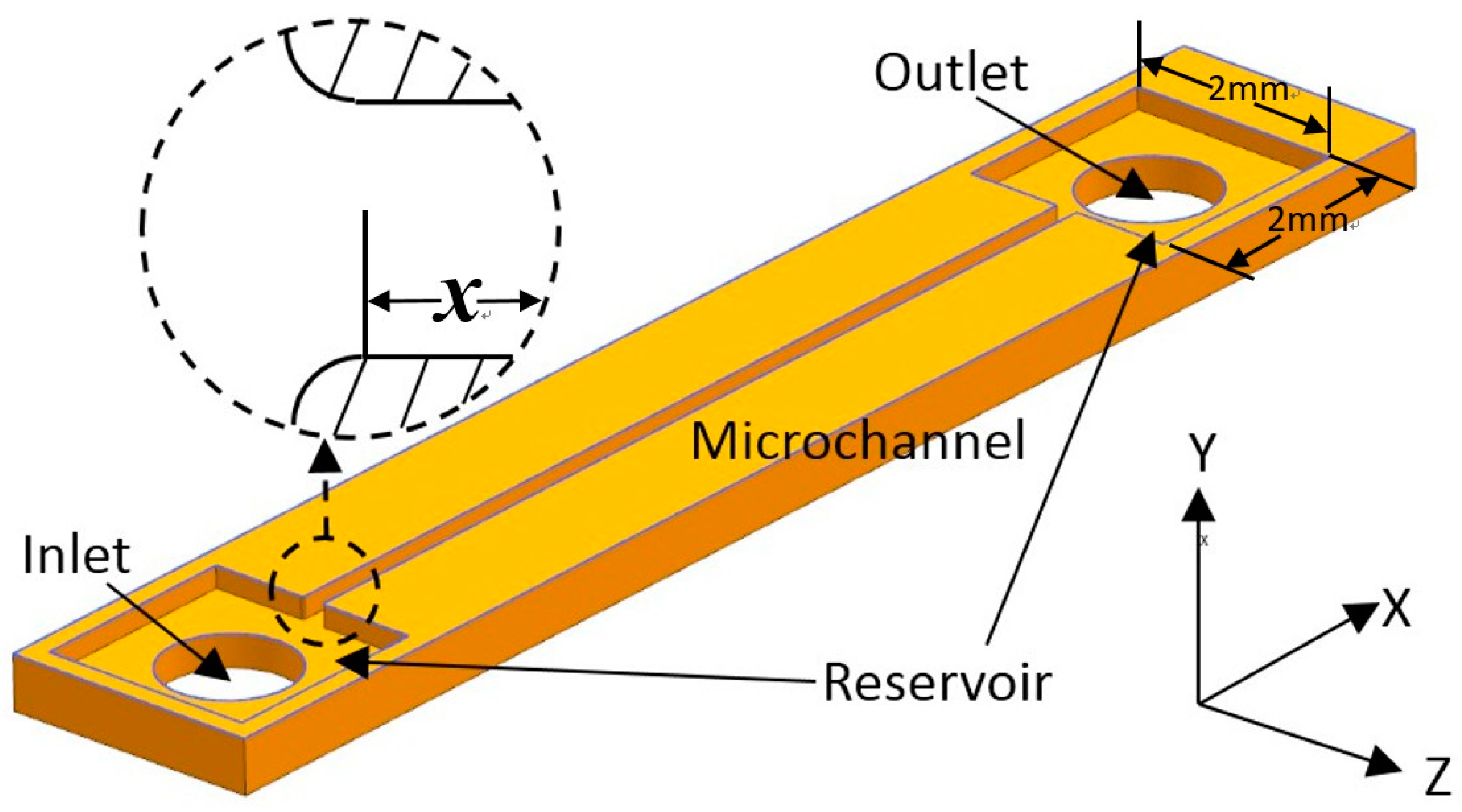

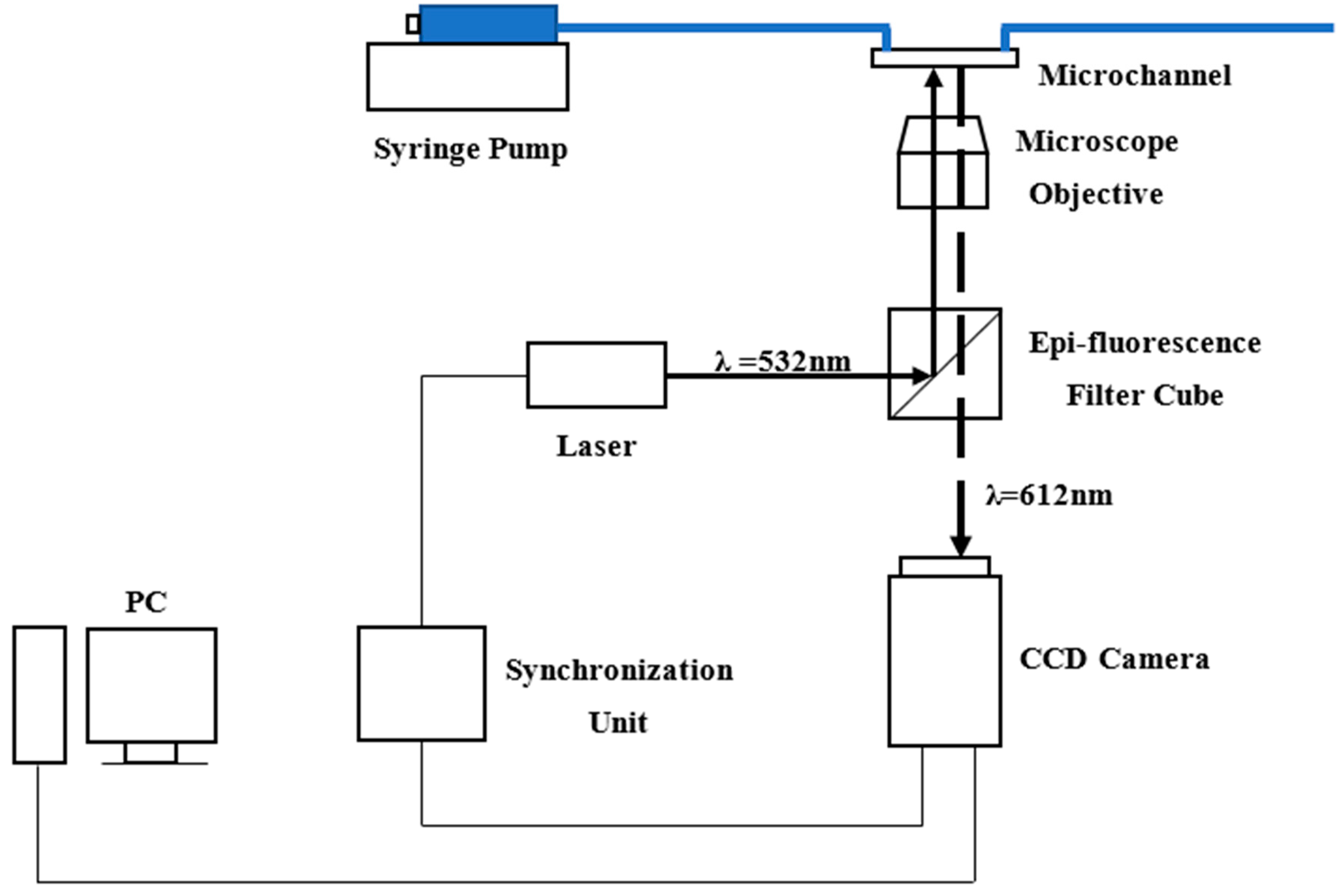
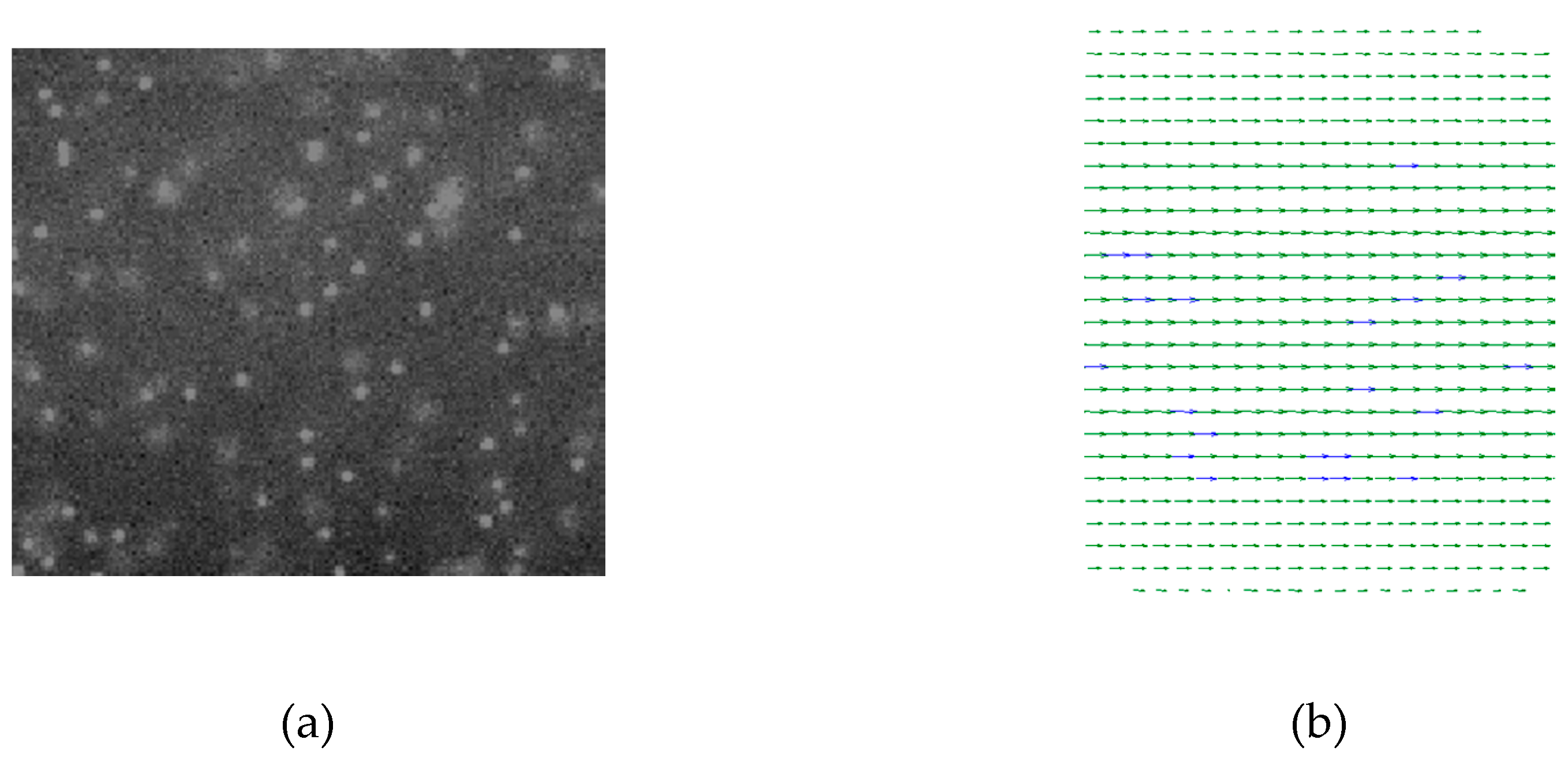
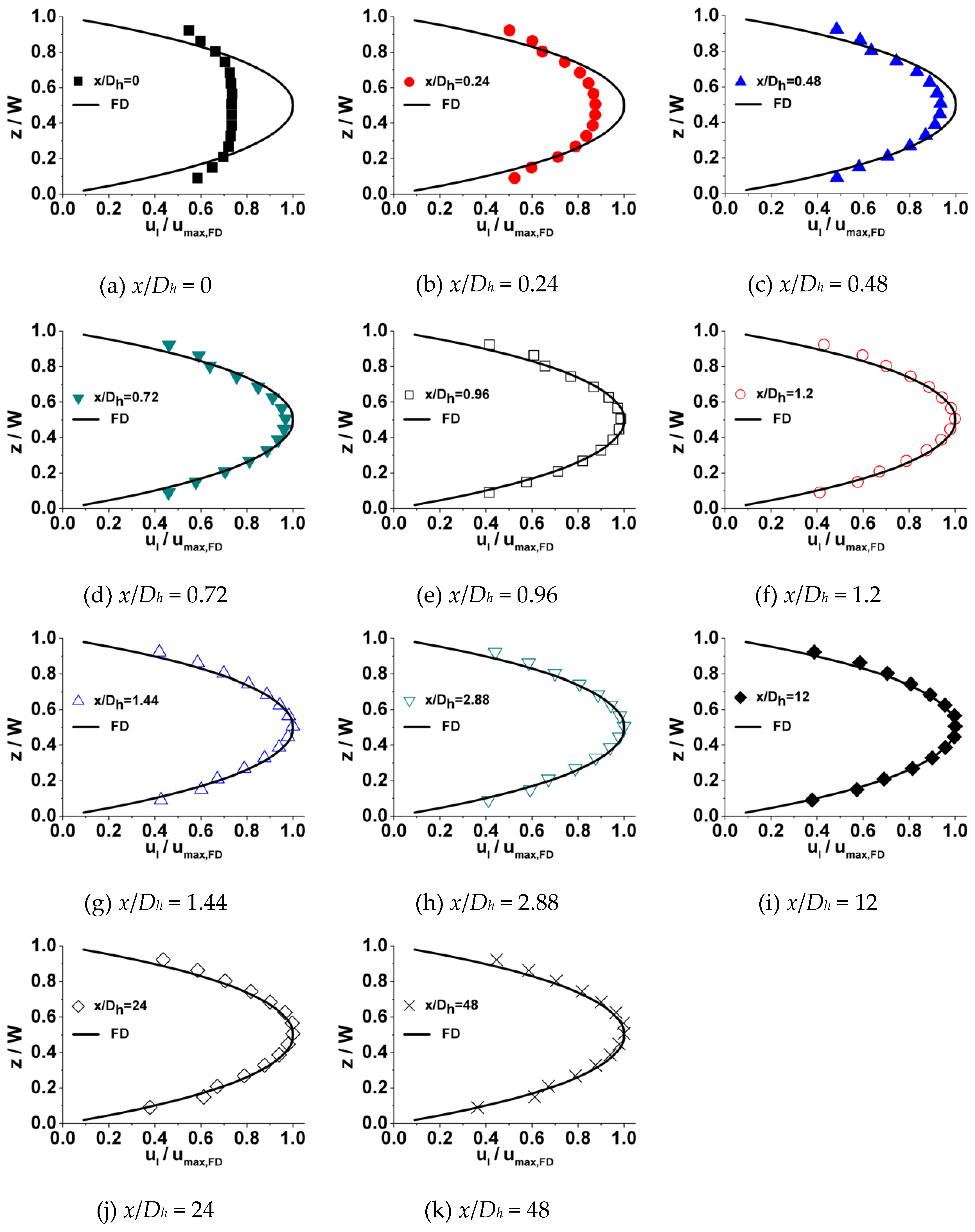
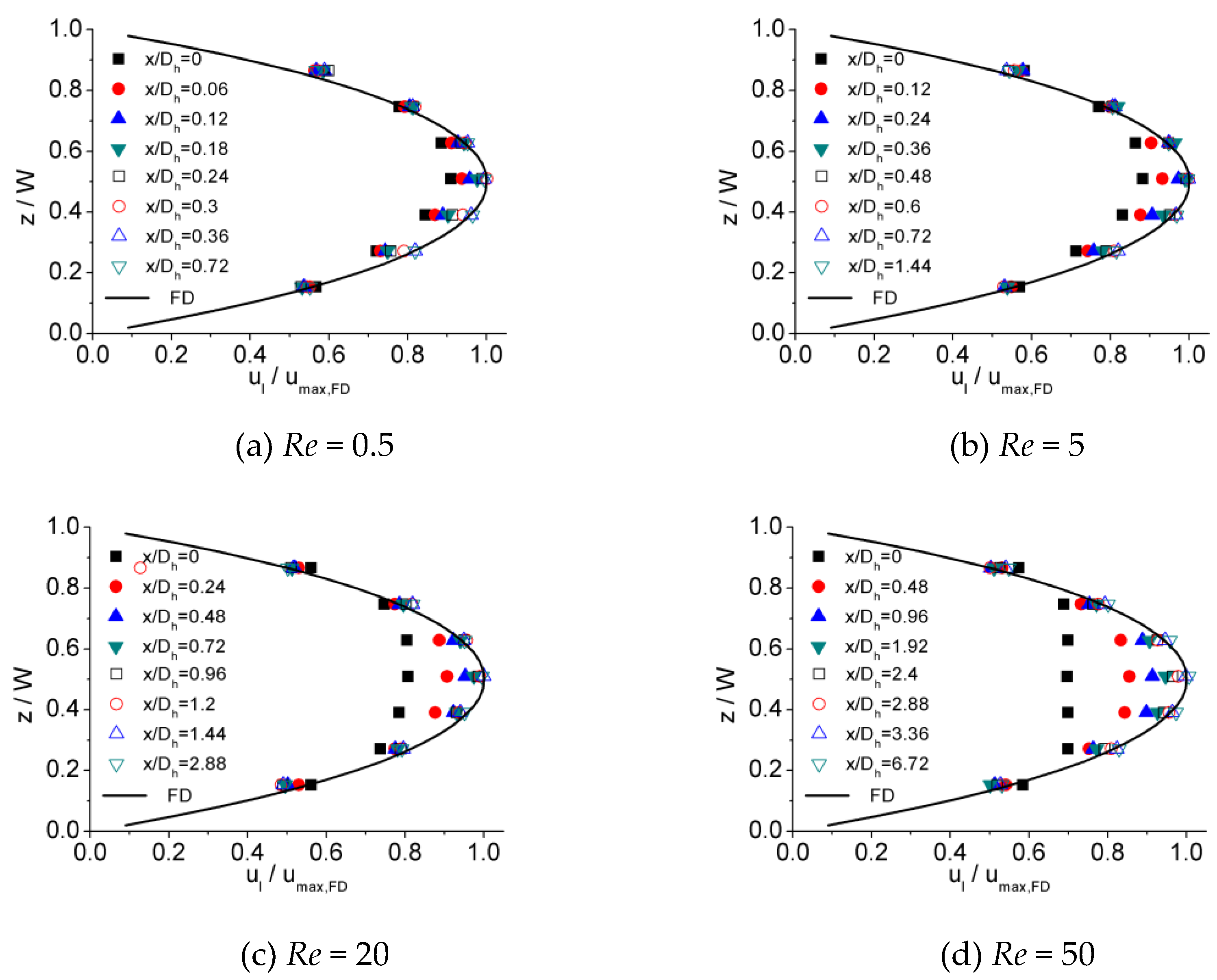
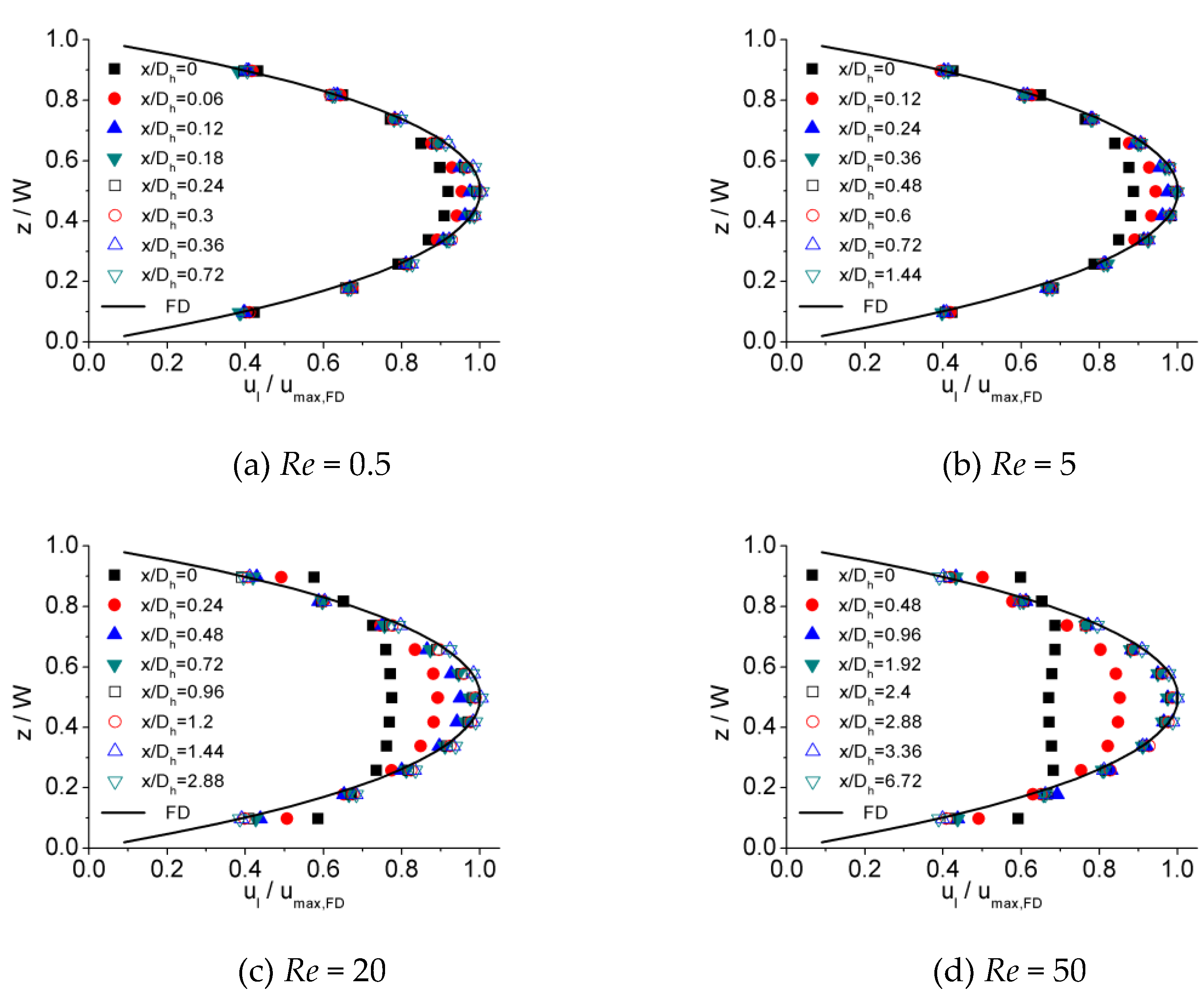
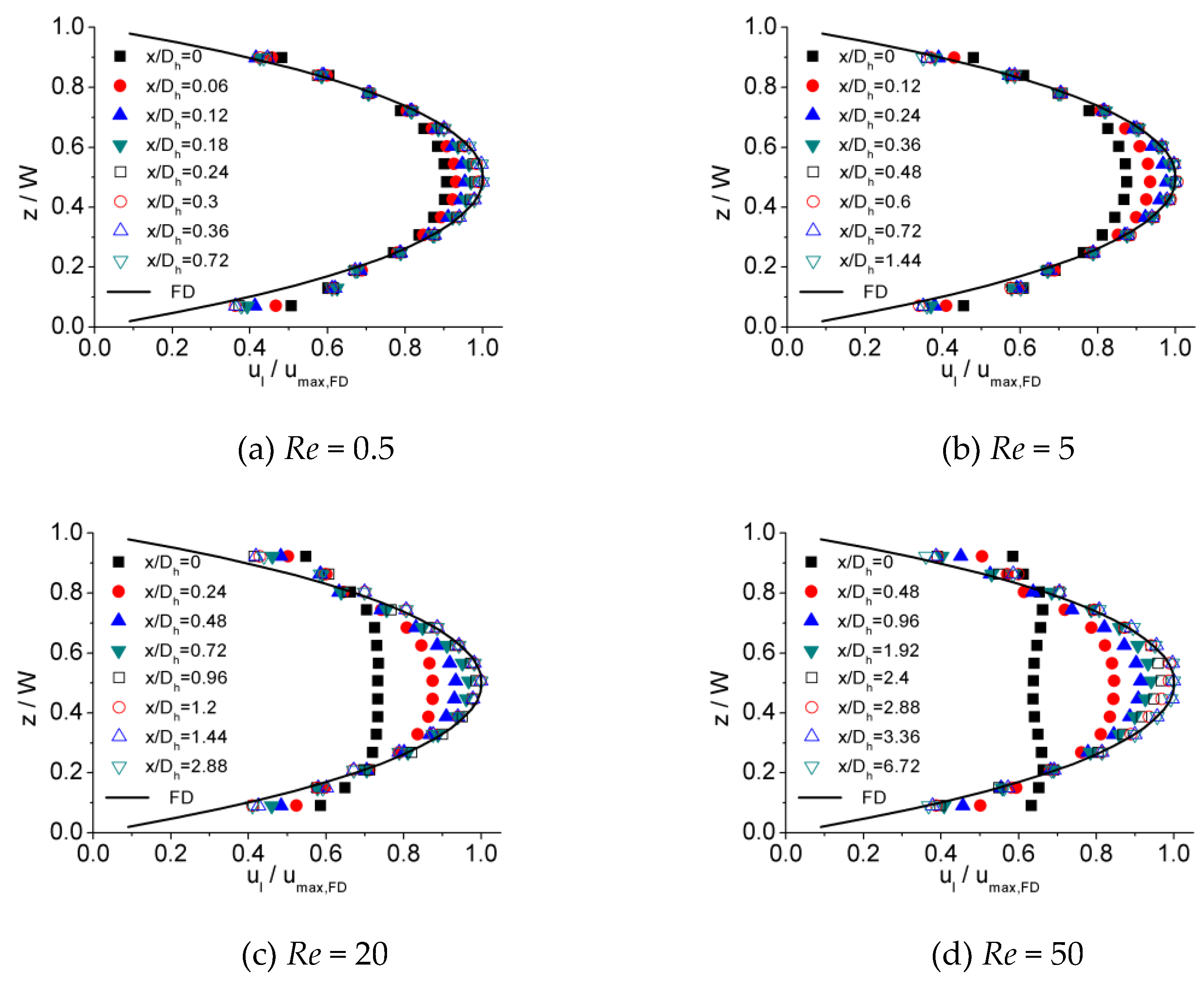
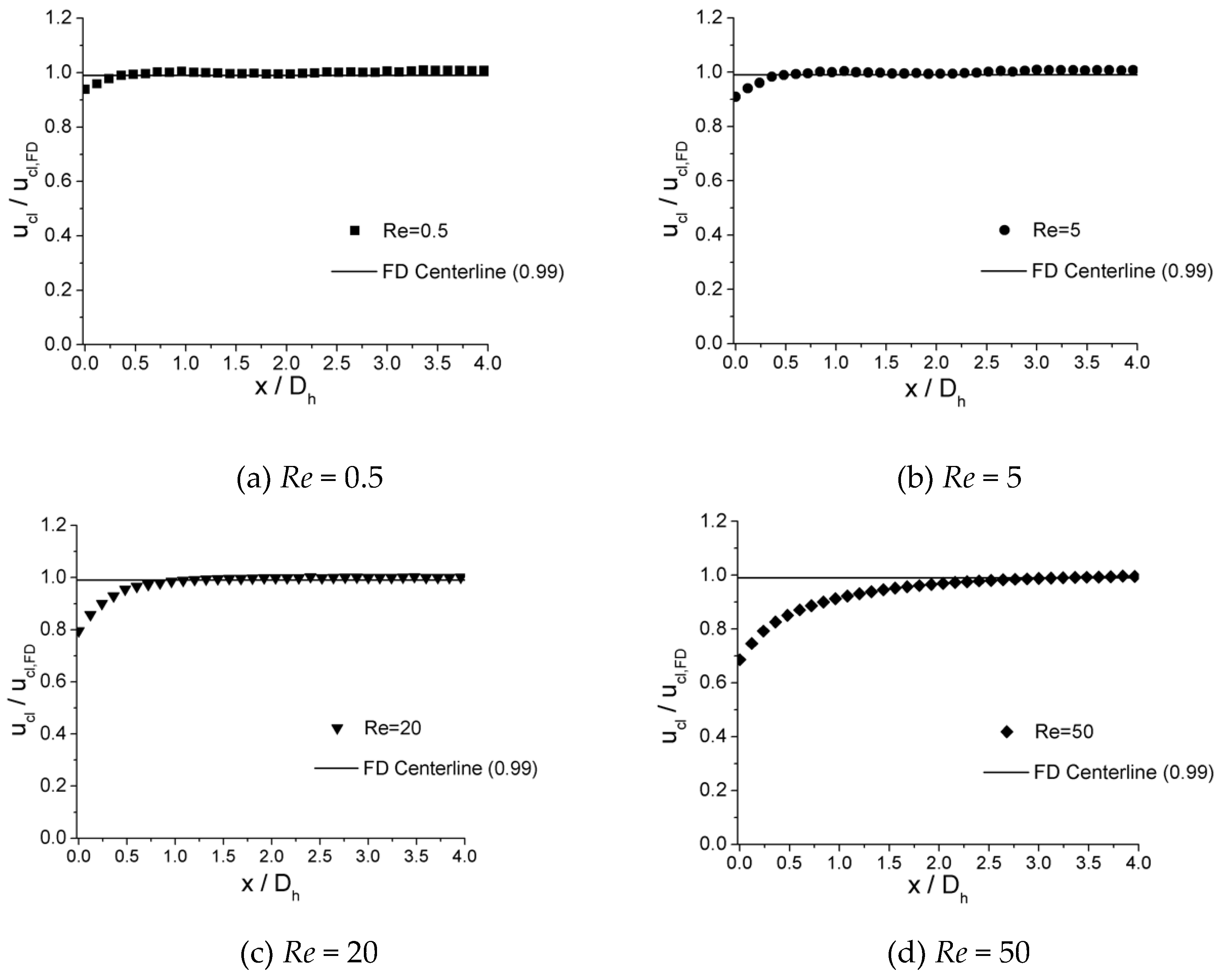


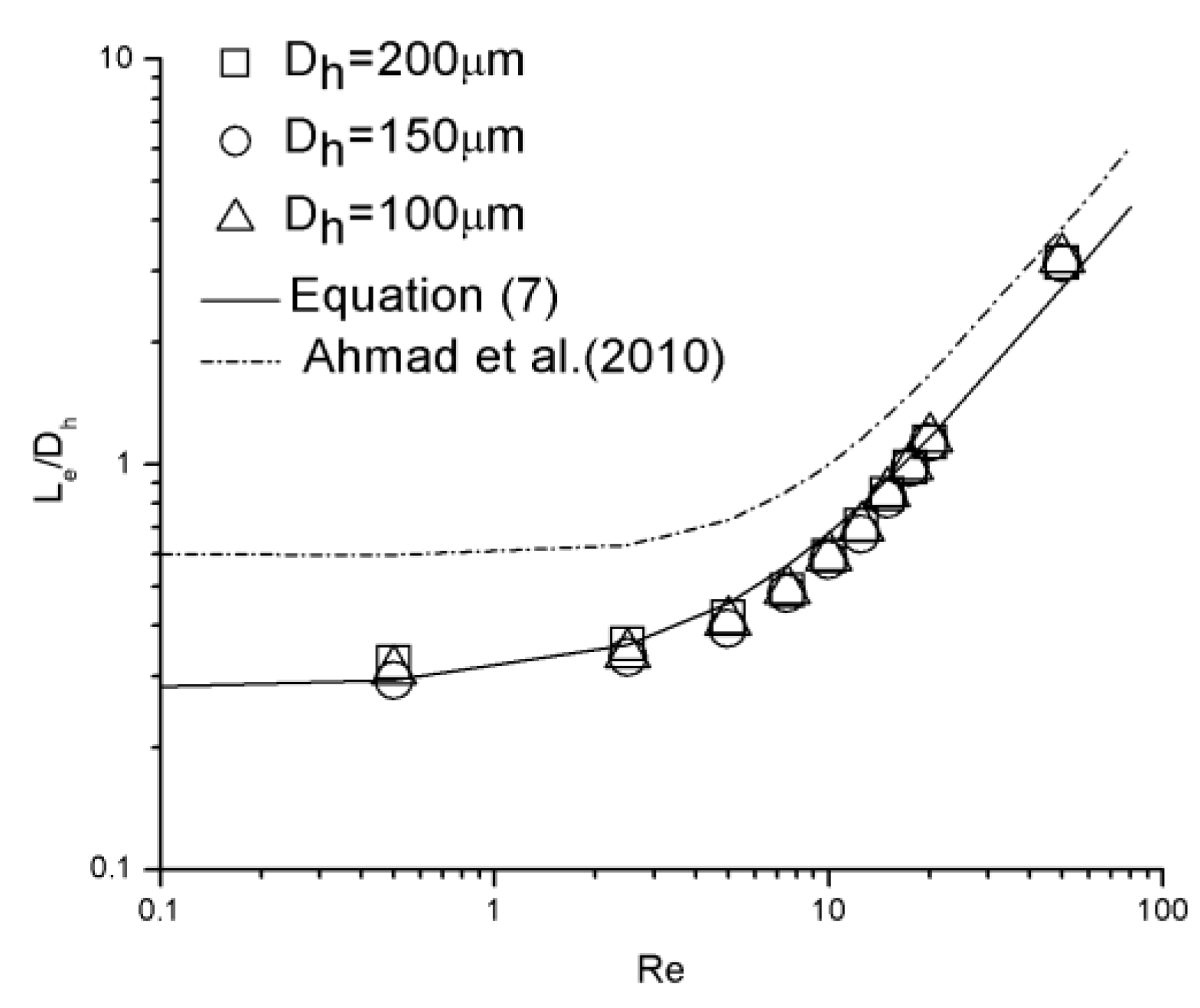
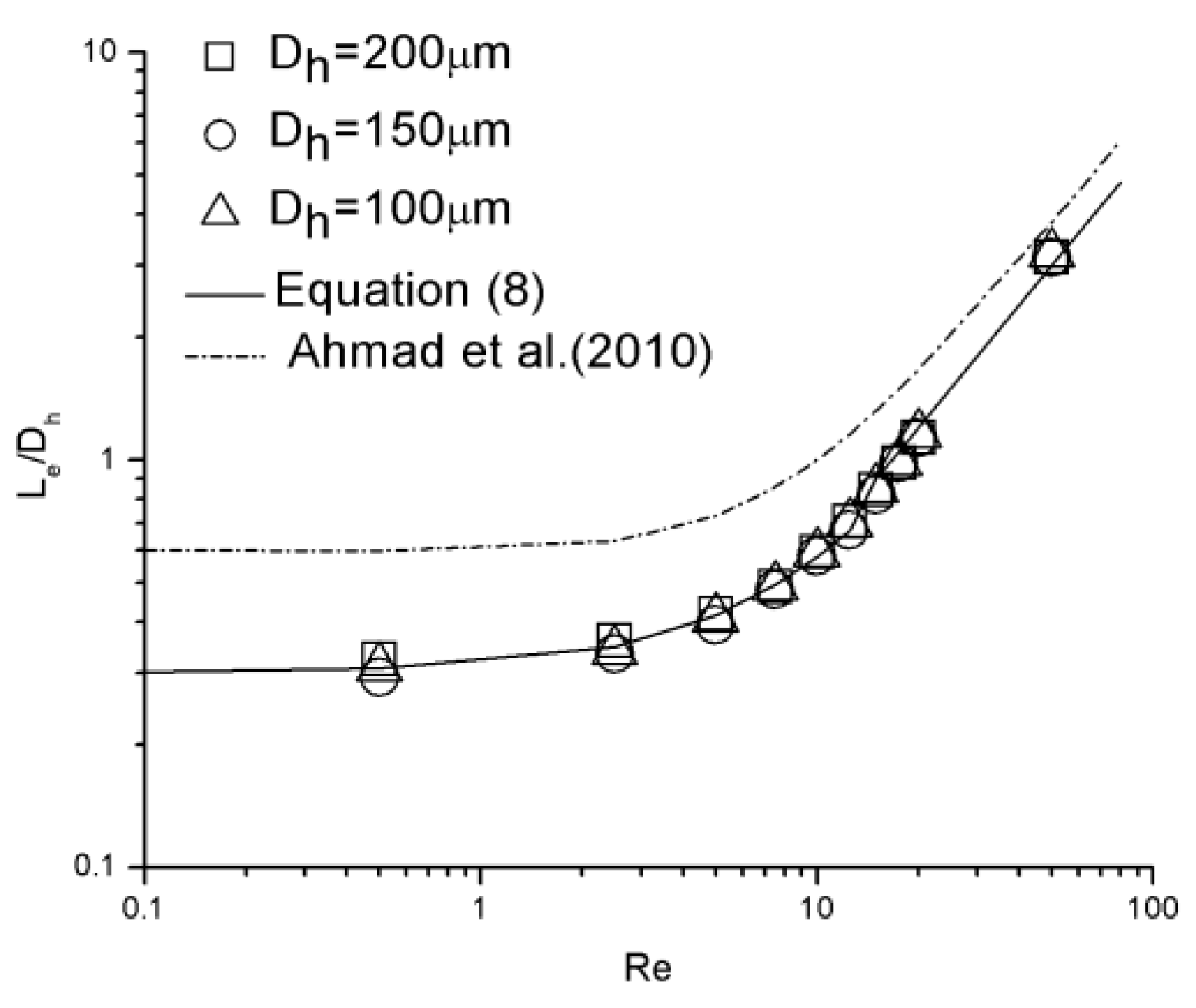
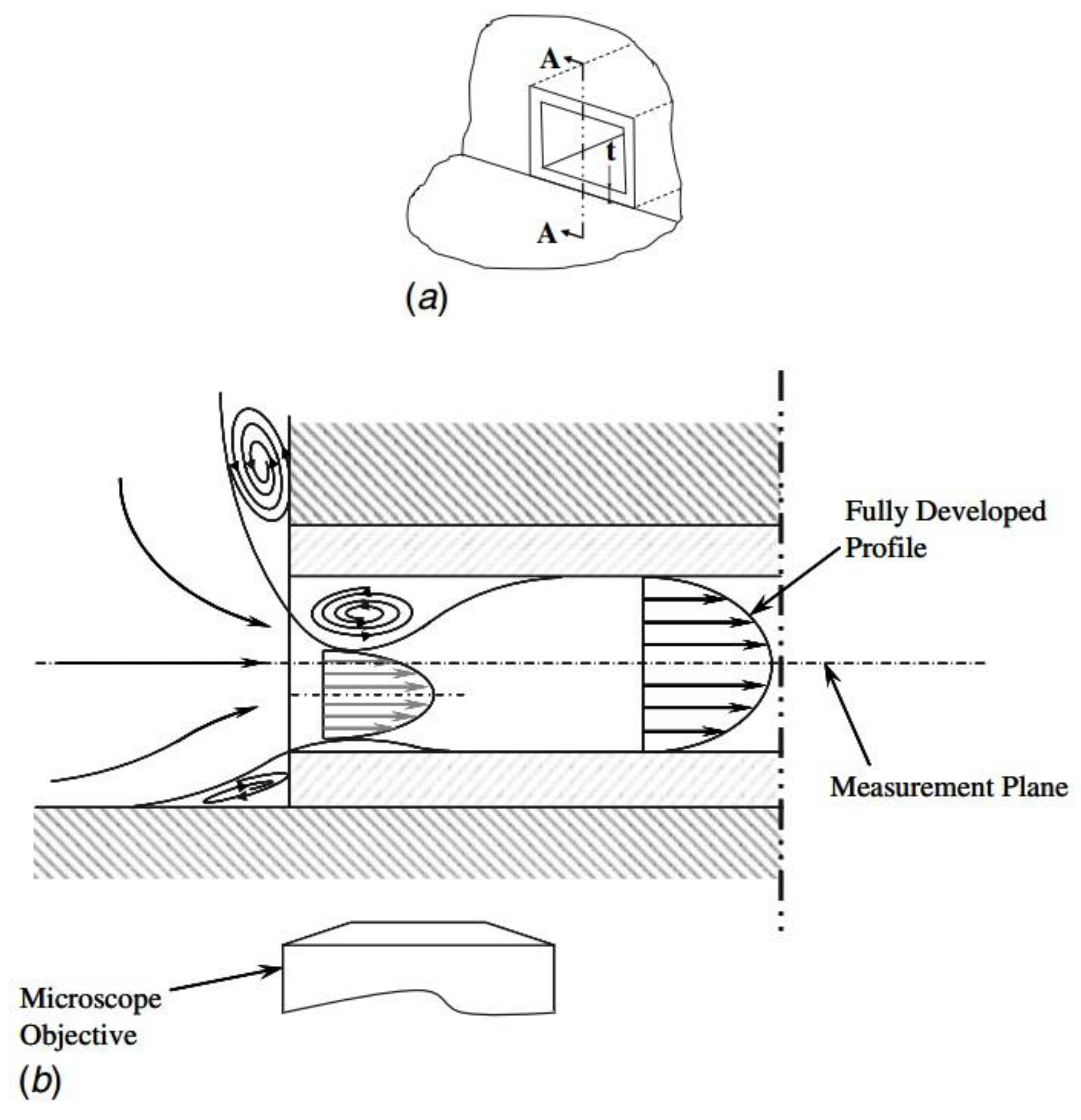
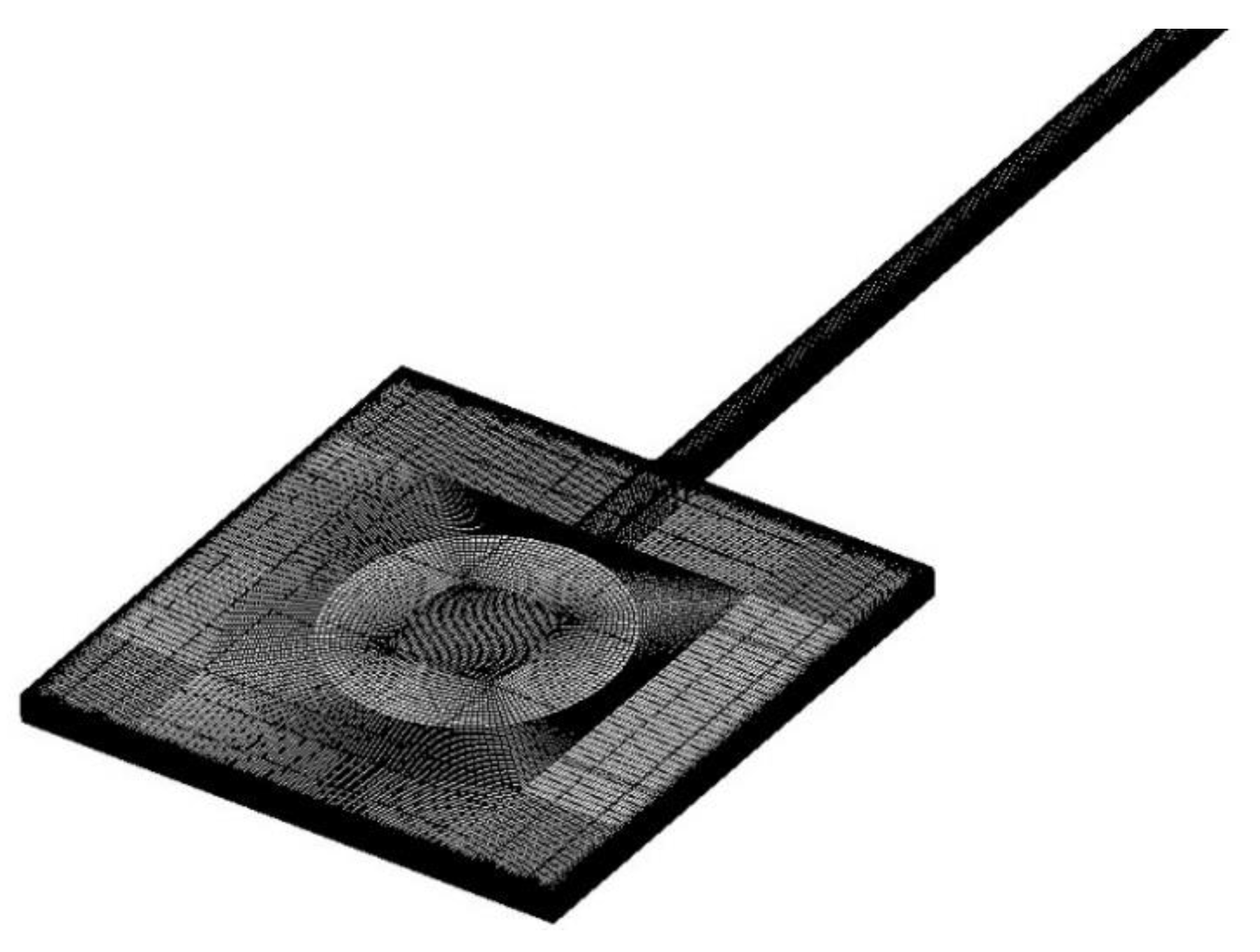
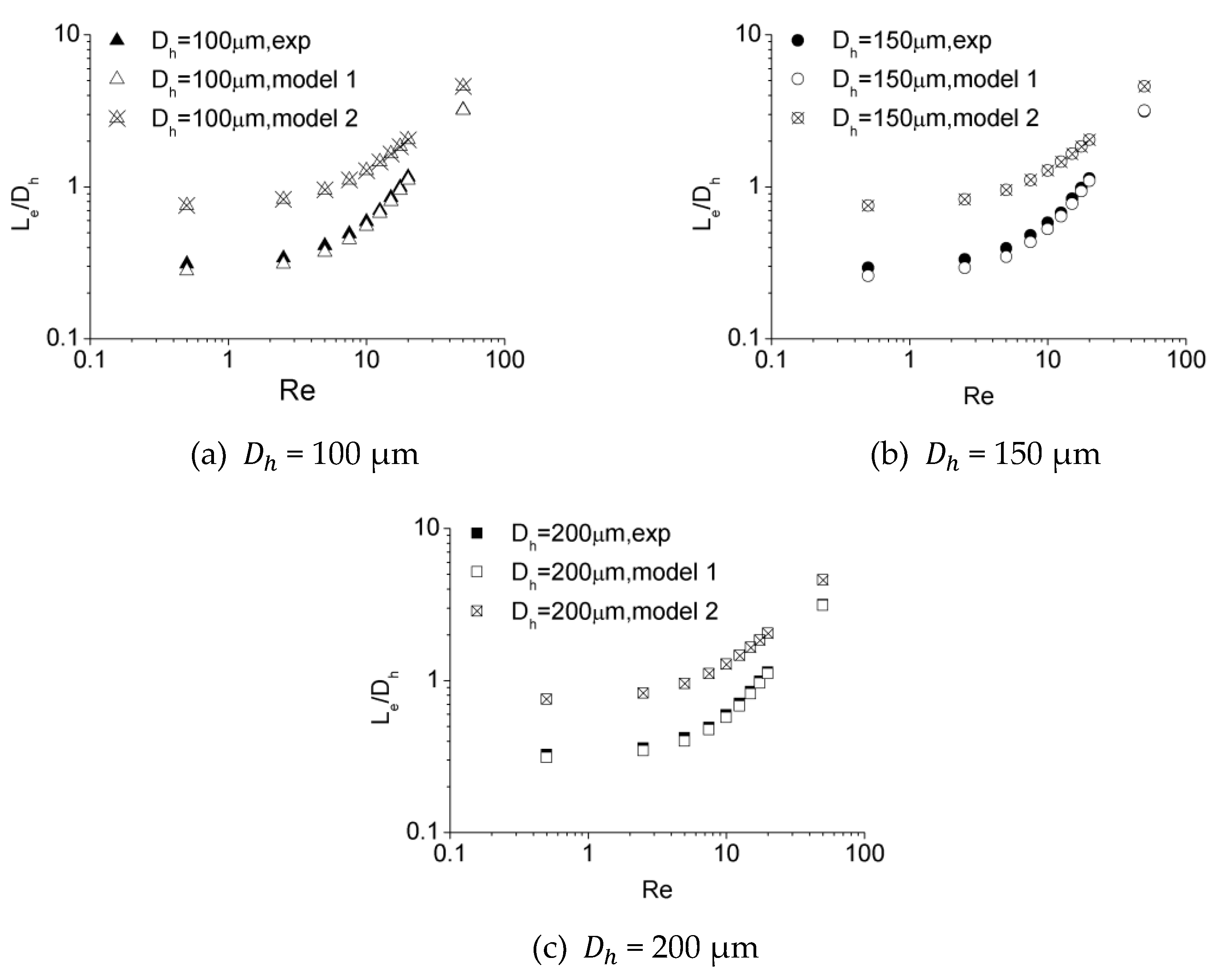

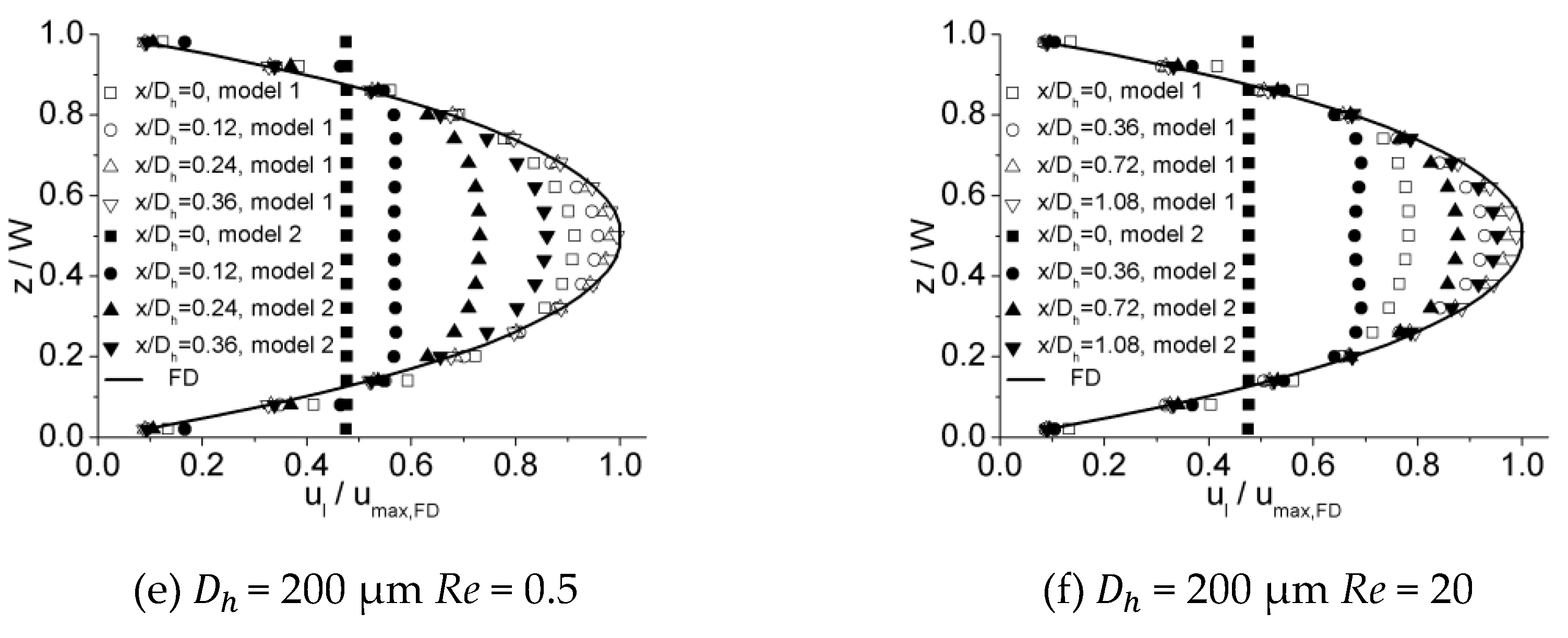
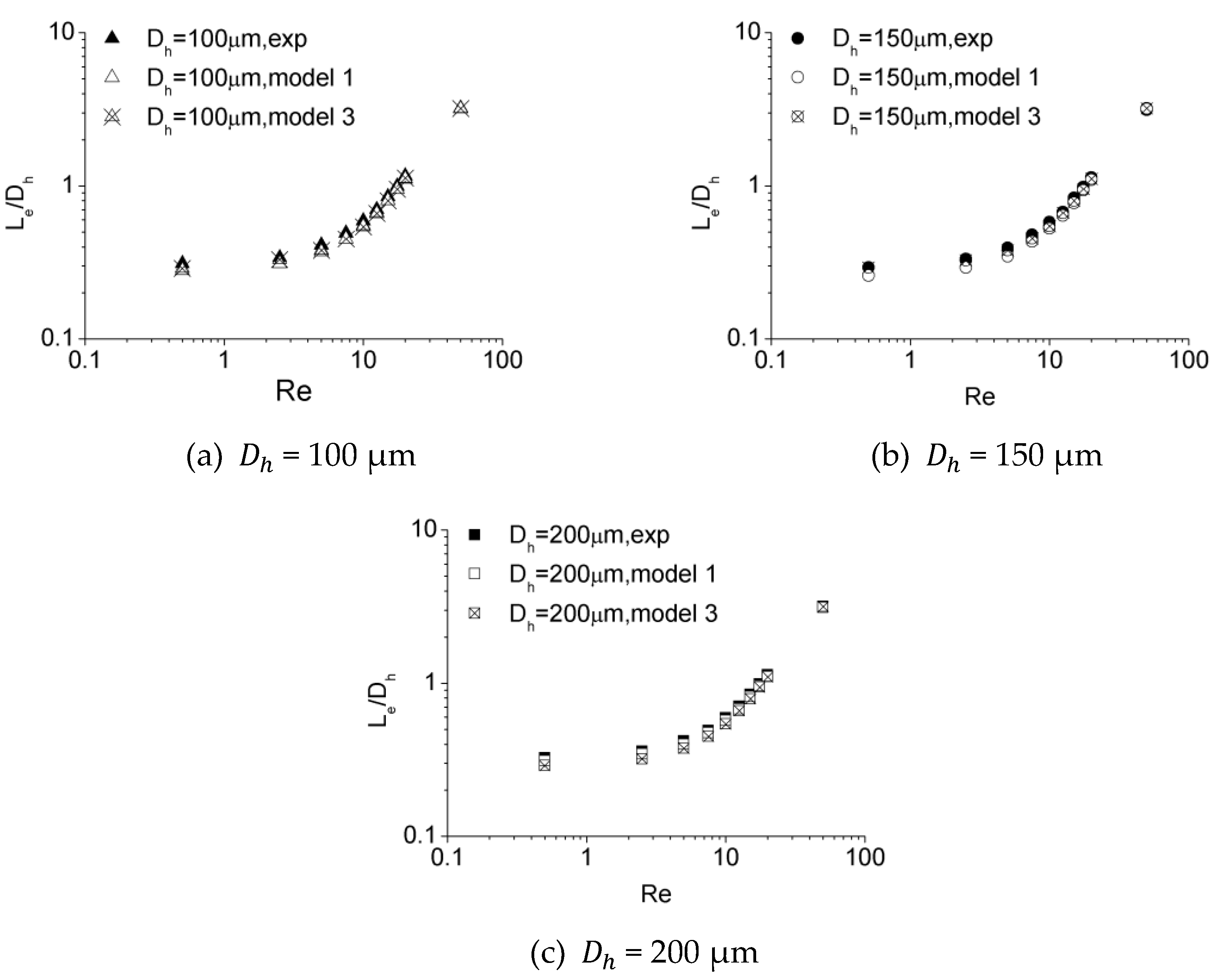
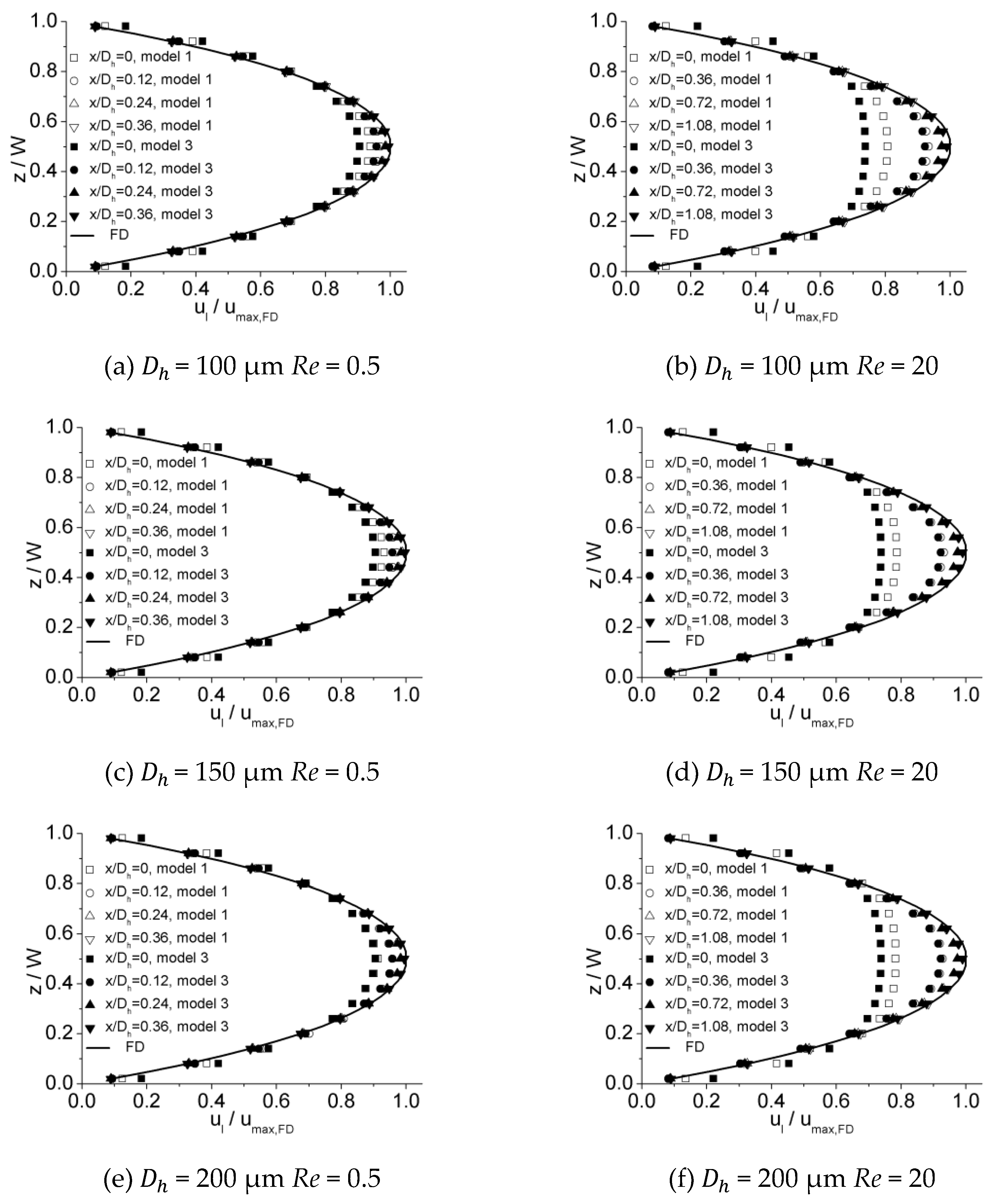
| Correlations | A | B | C |
|---|---|---|---|
| Atkinson et al. [19] | |||
| Tube | 0.590 | 0.056 | – |
| Parallel plates | 0.625 | 0.044 | – |
| Chen [20] | |||
| Tube | 0.600 | 0.035 | 0.056 |
| Parallel plates | 0.630 | 0.035 | 0.044 |
| Reference | Size of Microchannel | Range of Re Number | Conclusions |
|---|---|---|---|
| Zhang et al. [27] | 50–254 μm in diameter | Velocity distribution measured by micro-PIV was in strong agreement with the value calculated by the Navier–Stokes equation. | |
| Lee et al. [28] | 690 μm in height 260 μm in width | 250–2100 | Fluid had been pre-developed in pipe before entering the microchannel, causing a shorter entrance length. |
| Lee and Kim [29] | 58 μm in depth 100 μm in width | 1 | Entrance length for microchannels is much smaller compared with conventional channels. |
| Hao et al. [30] | 237 μm in hydraulic diameter | 50–1200 | |
| Ahmad and Hassan [31] | 100, 200, and 500 μm in hydraulic diameter | 0.5–200 |
| Mesh No. | Nodes | Elements | r | ε | |
|---|---|---|---|---|---|
| 1 | 1147384 | 1066770 | 2270.29 | - | - |
| 2 | 1582848 | 1485551 | 2269.04 | 1.39 | −0.059% |
| 3 | 2025528 | 1918673 | 2267.84 | 1.29 | −0.079% |
| 4 | 2518888 | 2401230 | 2266.97 | 1.25 | −0.068% |
| 5 | 3242004 | 3126872 | 2266.28 | 1.30 | −0.043% |
© 2019 by the authors. Licensee MDPI, Basel, Switzerland. This article is an open access article distributed under the terms and conditions of the Creative Commons Attribution (CC BY) license (http://creativecommons.org/licenses/by/4.0/).
Share and Cite
Li, H.; Huang, B.; Wu, M. Experimental and Numerical Investigations on the Flow Characteristics within Hydrodynamic Entrance Regions in Microchannels. Micromachines 2019, 10, 317. https://doi.org/10.3390/mi10050317
Li H, Huang B, Wu M. Experimental and Numerical Investigations on the Flow Characteristics within Hydrodynamic Entrance Regions in Microchannels. Micromachines. 2019; 10(5):317. https://doi.org/10.3390/mi10050317
Chicago/Turabian StyleLi, Haiwang, Binghuan Huang, and Min Wu. 2019. "Experimental and Numerical Investigations on the Flow Characteristics within Hydrodynamic Entrance Regions in Microchannels" Micromachines 10, no. 5: 317. https://doi.org/10.3390/mi10050317
APA StyleLi, H., Huang, B., & Wu, M. (2019). Experimental and Numerical Investigations on the Flow Characteristics within Hydrodynamic Entrance Regions in Microchannels. Micromachines, 10(5), 317. https://doi.org/10.3390/mi10050317




